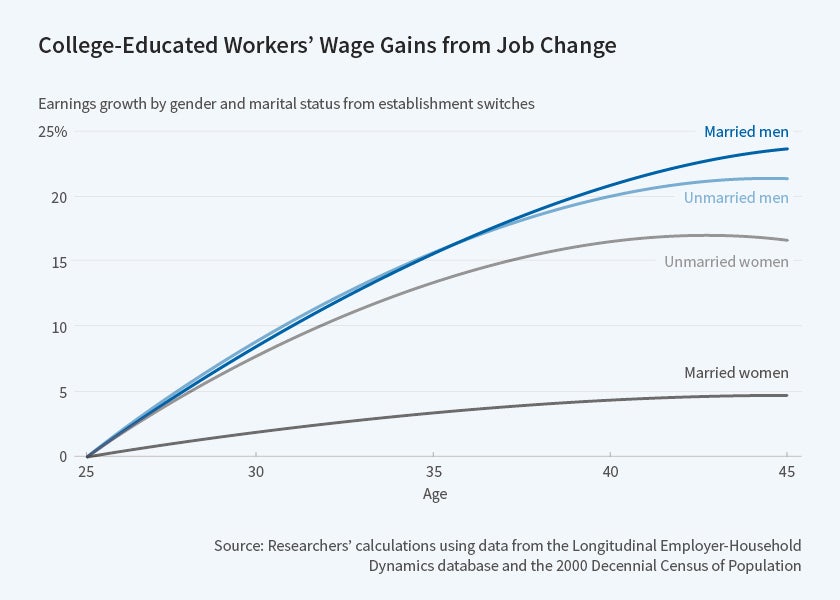The Gender Pay Gap Widens with Age
Earnings growth for married men with college degrees is substantially higher than for comparably qualified married women over the course of their prime working years.
Despite dramatic workforce gains by women in recent decades, a substantial gender earnings gap persists. In The Dynamics of Gender Earnings Differentials: Evidence from Establishment Data (NBER Working Paper 23381), Erling Barth, Sari Pekkala Kerr, and Claudia Olivetti find that this gap increases in magnitude over the course of men's and women's careers, particularly for those who are married. Their study explores various drivers of both the overall earnings gap and the manner in which it widens over time. Their analysis is based on an observation that there are earnings differences across establishments, and a key question is thus the extent to which the widening of the gender pay gap over time arises from differences in career advances within the same establishment versus differential gains from job-to-job moves across establishments over their careers.
The researchers divide the change in the gender earnings gap as men and women age into the "within-establishment" gap and the "between-establishment" gap. The first — the within-establishment gap, or the pay gap between male and female workers at the same firm or establishment — arises mostly from promotions and raises that workers at a given establishment accrue over time. The between-establishment gap — the pay gap due to workers sorting at different firms — is driven by the presence of different wage levels across firms and gender-based variation in the likelihood that a worker will both change jobs and receive a higher salary as a result of that job change.
The researchers point out that women may face both between- and within-establishment gaps. Due to family and caretaking obligations, women may be less able to put in the long hours required to score a big promotion at their employer, or to invest in the networking and job search activities that facilitate financially advantageous job changes. These effects may be compounded if employers believe that women are less likely to remain in the labor force over the long term, or if women are less likely to seek promotions and raises within and across firms in anticipation of needing more time flexibility or because of family location decisions in which the career of the primary earner, usually the husband, takes precedence.
Using data from the 2000 Decennial Census of the United States and the Longitudinal Employer-Household Dynamics (LEHD) database, the researchers study the earnings trajectories of workers aged 25-44 in relatively permanent work arrangements in large metropolitan areas between 1995 and 2008. Consistent with past research, they find a substantial gender earnings gap that widens with age among the workers in the sample. Earnings growth for men with college degrees is on average 50 percent higher than for comparably qualified women over the course of their prime working years. The gender difference in earnings growth is much smaller — only about 3 percentage points — for workers without a degree.
Within-establishment and between-establishment gaps affect different types of workers differently. For workers without a college degree, the within-establishment gap is not a significant contributor to the change in the earnings gap over time. It increases between the ages of 25 and 35, but then narrows. By the age of 45, women in this group have caught up to, and surpassed, men with respect to within-establishment earnings growth. The between-establishment gap is the sole driver of the widening of the gender earnings gap over time for this group.
The opposite is true for workers with a college degree, for whom the within-establishment gap is large, sustained, and the main driver of the widening of the gender earnings gap. While the between- establishment gender gap also widens over time for college-educated men and women, it explains only 27 percent of the widening of the total gender wage gap for this group.
The researchers find that the between-establishment earnings gap arises almost entirely from the earnings trajectories of married workers. The development of the establishment pay premium looks about the same for never-married men, never-married women, and married men; married women, however, lag dramatically. The slowdown in their average earnings growth coincides with the traditional child-bearing years. The researchers suggest that this may indicate that the division of labor among married couples limits women's career choices and contributes to the widening of the overall gender earnings gap.
— Dwyer Gunn



